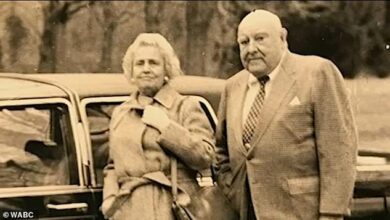Did Queen Victoria really marry her beloved servant John Brown, or was it a ‘misogynistic’ rumour? The Mail’s Robert Hardman and historian Kate Williams explore the couple’s VERY intimate relationship in a new podcast

He was the strong Highlander with a face ‘hewn from granite’, and she was the grieving monarch in the deepest misery.
The relationship between Queen Victoria and her beloved servant John Brown, who became her best friend after the death of her husband Prince Albert, has been the subject of intrigue for over a century.
In the Mail’s new podcast, columnist and royal biographer Robert Hardman and historian Professor Kate Williams investigates how Brown’s relationship with Victoria blossomed over more than two decades.
They were so intimate that it is rumoured they slept in adjoining rooms. The Queen referred to him in letters as ‘darling’.
And when the Queen died in 1901, she was buried with the wedding ring that had once belonged to Brown’s mother.
But did she really marry the 6ft 1in Scottish woman in a kilt in a secret ceremony near Balmoral, her beloved Scottish estate?
That is the core question in the second episode of Queens, Kings and Cowardly Thingsreleased today.
Speaking of the podcastProfessor Williams says: ‘It’s the million-dollar question. And it’s the question the Victorians asked.’
Did Queen Victoria Really Marry in Secret? Find out by listening to the full episode here

The relationship between Queen Victoria and her beloved servant John Brown, who became her best friend after the death of her husband Prince Albert, has been the subject of intrigue for over a century.

John Brown became Queen Victoria’s most trusted servant after the death of Prince Albert
Victoria first developed a close relationship with Brown after she and Albert took over the lease of Balmoral in 1848.
Brown, then 21, had lived in the area since childhood and was working as a ghillie – the Scots word for field servant – when the Queen and her husband arrived.
The ‘tall, silent Highlander with watchful eyes and a face that seemed to have been hewn from granite’ – as he was described by the monarch’s private secretary – was appointed by Albert to lead the Queen’s pony.
In his role he accompanied Victoria as she rode her horse through the countryside around Balmoral.
As Brown helped her improve her riding skills, the two grew closer.
But it was the tragic death of Prince Albert from typhoid in 1861 that further deepened their relationship.
While the penniless monarch spent her time in seclusion at Osborne House on the Isle of Wight, Princess Alice, the Queen’s daughter, suggested that Brown come over from Scotland with her pony.
The last rides with Brown left the queen feeling reborn and increasingly dependent on her servant, who increasingly regarded himself as her bodyguard.
But the close bond between Victoria and her other servants made them increasingly angry.
However, Victoria refused to listen to her family and courtiers and demanded that Brown accompany her everywhere.
He was at her side when a teenager made the last of several attempts on the queen’s life in 1872.
Armed with a pistol, teenager Arthur O’Connor climbed over the fence at Buckingham Palace and waited for the Queen as she returned from a service at St Paul’s Cathedral.

In libellous newspaper columns, the monarch was referred to as ‘Mrs Brown’, a name that became the title of the 1997 film starring Judi Dench as the queen and Billy Connolly as her beloved servant

Brown served Queen Victoria for more than 20 years

John Brown (centre in a kilt) stands beside Queen Victoria’s carriage, preparing to alight at Windsor to inspect 52,000 volunteers, 1881. On the left is her son, the future King Edward VII.
But O’Connor’s plan to point his gun to the Queen’s head was foiled by Brown, who grabbed him after he dropped his gun.
The servant’s role in saving the queen cemented his position in her love, but it also deepened her dislike for him and led to further rumors about their relationship.
In 1885, it was claimed that the Queen’s chaplain, the Reverend Norman Macleod, had made a stunning deathbed confession, which has been studied by historians ever since.
He claimed to have officiated at the wedding of Victoria and Brown at Crathie Kirk in Scotland.
Although the claim is disputed, some historians, such as biographer AN Wilson, believe the ceremony actually took place.
In libellous newspaper columns, the monarch was referred to as “Mrs Brown”, a name that later became the title of the 1997 film starring Judi Dench as the queen and Billy Connolly as her beloved servant.
It was also claimed that Brown slept in a room adjoining the Queen’s bedroom.
“I think sometimes he is there, and that’s because she sees him as a protector, as a bodyguard,” says Professor Williams.
This revelation prompted the Foreign Secretary, the Earl of Derby, to say that the arrangement was ‘contrary to etiquette and even to decency.’
On the podcast of the MailAccording to Mr Hardman, many of the rumours appeared to have an “anti-woman slant”.
“I mean, male monarchs have always had favorites and mistresses, and no one has ever felt inferior to them,” he says.
‘Queens can’t do that, can they?’
In August 1876, on Prince Albert’s birthday, Brown was given a portrait of herself that Victoria had commissioned.
Seven years later, however, Brown fell ill with an infection, and his death in March 1883 sent the Queen into a new descent into despair.
As a further sign of her admiration for the sturdy, six-foot-tall Gillie, Victoria commissioned Alfred Lord Tennyson, one of Britain’s greatest writers, to write the inscription on his gravestone.
He was buried in Crathie Kirkyard, the royal family’s favourite church near Balmoral.
In a letter to former Home Secretary Viscount Cranbrook, only recovered in 2004, Victoria gave her views on Brown in the third person.
She wrote: ‘Perhaps never in history has there been such a strong and sincere bond, such a warm and loving friendship between the sovereign and his servant…’
The monarch called him “one of the most remarkable men” and said he had a “tender, warm heart” combined with “honesty, independence and selflessness”.

John Brown poses in a kilt, with ceremonial pistols on his hip

The grave of Queen Victoria’s loyal servant John Brown at Crathie Kirkyard near Balmoral
Further eulogy came in the form of a life-size statue of Brown, which Victoria had placed at Balmoral.
The inscription read: ‘Friend more than servant. Loyal. Truthful. Brave. Self less than duty, even unto the grave.’
Further evidence of their relationship may be found in Victoria’s memoirs of Brown, but her courtiers refused to publish them and had them destroyed, along with the servant’s own journals.
Shortly before her death in 1901, Victoria demanded that Brown’s mother’s wedding ring, which he had given her, be placed on her right hand.
She also wanted a picture of him in her left hand, hidden by flowers.
Also in her coffin was a lock of Brown’s hair and some of his letters to her.
It was the ultimate, definitive sign of the esteem she held for the brazen Scot.
Listen to episode two by Queens, Kings and Cowardly Things to hear the verdict of Professor Williams and Robert Hardman on Victoria’s relationship with Brown.
Robert Hardman is the author of books such as Queen of Our Times: The Life of Elizabeth II and Charles III: New King. New Court. The Inside Story.
Professor Kate Williams is the author of the 2018 book Rival Queens: The Betrayal of Mary, Queen of Scots, and many other works.





